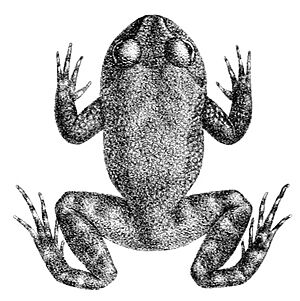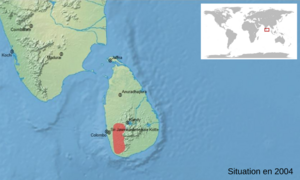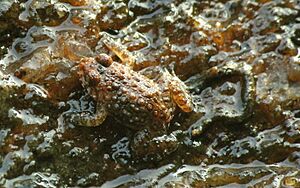Sri Lanka rock frog facts for kids
Quick facts for kids Sri Lanka rock frog |
|
|---|---|
 |
|
| Conservation status | |
| Scientific classification | |
 |
The Sri Lanka rock frog (also known as the Ceylon streamlined frog) is a special type of frog. Its scientific name is Nannophrys ceylonensis. This frog used to be grouped with a large family of frogs called Ranidae. But after scientists studied its DNA, they found it belongs to a different family, the Dicroglossidae. This frog is only found in Sri Lanka, which means it is endemic there. It lives in wet places like tropical forests, rivers, and streams.
Contents
What Does the Sri Lanka Rock Frog Look Like?
Female Sri Lanka rock frogs can grow to about 5 centimeters (2 inches) long. Males are a bit smaller, reaching about 4 centimeters (1.6 inches).
Their skin is usually olive green or yellowish-brown. It has brown patches that help them blend in. Their legs also have brown stripes. When these frogs sit on rocks covered in algae, they are very hard to spot! This is a great way for them to hide from predators.
Where Do Sri Lanka Rock Frogs Live?
The Sri Lanka rock frog lives only in certain parts of Sri Lanka. You can find them in the south, central, and western areas. They prefer wet tropical forests, living at heights up to 1,200 meters (about 3,900 feet) above sea level.
These frogs love water. They are often found in fast-flowing mountain streams. They hide under large rocks or on wet rocks near waterfalls. Sometimes, they are also found on land in disturbed areas. This happens if there are good wet spots for them to lay eggs. Their tadpoles can even live on wet rocks next to fast-moving water.
Reproduction and Life Cycle
Female Sri Lanka rock frogs lay their eggs in a special way. They usually place a cluster of eggs in a small crack or hole. These spots are often in the "splash zone" of a mountain stream. This means the eggs get splashed with water, keeping them moist.
After the eggs are laid, the male frog takes over. He guards the eggs in several nests. He makes sure they stay wet so they can develop properly. The female frog does not help with caring for the eggs after she lays them. The eggs hatch into tiny tadpoles. These tadpoles then search for small bugs and other tiny creatures to eat on the surface of the rocks near their nest.
Why Are Sri Lanka Rock Frogs Vulnerable?
The Sri Lanka rock frog is listed as a Vulnerable species. This means their numbers seem to be going down. Also, the places where they live are spread out and not connected. The total area where they are found is less than 2,000 square kilometers (about 770 square miles).
The streams where these frogs live and breed face problems. They can get dirty from farm chemicals. Also, during dry times, the amount of water in these streams can get very low. These issues threaten the frogs' homes and their ability to survive.



